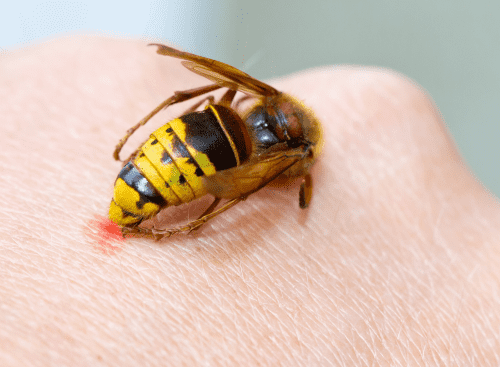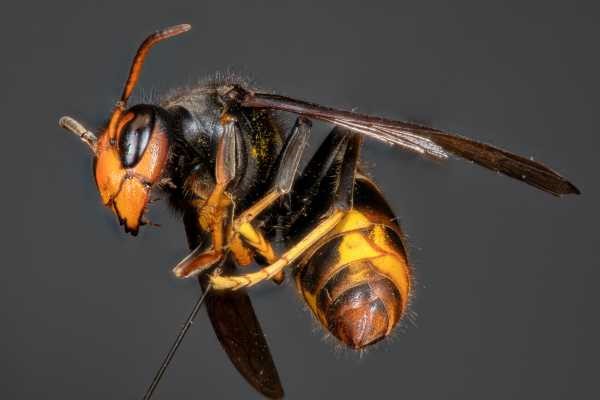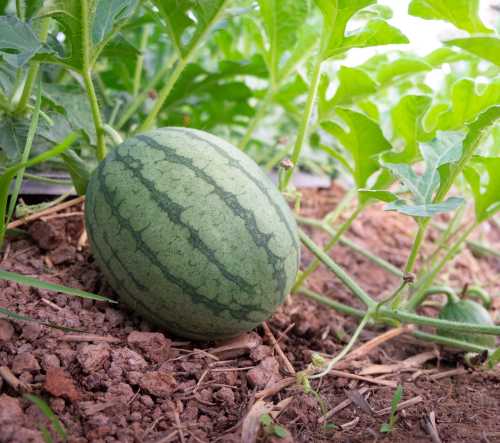Do Bees And Hornets Have The Same Venom?
If you have read my page describing how honey bees defend their colonies from attacks by hornets, you may be wondering how a hornet sting would compare with a bee sting, and in particular, whether or not bees and hornets have the same venom.
The short answer is:
No, bee and hornet venom are not quite the same, although they have some chemical components in common. Toxicity level and ability to deliver pain may vary between bee and hornet species, and depending on whether multiple stings are experienced.
Do Bees And Hornets Have The Same Venom In Their Stings?
No, scientists have found that bee venom and hornet and wasp venom have a different chemical composition, although they do have some chemicals in common, such as histamine, a major cause of irritation and pain, and alarm pheromones, to alert colony mates and members of the same species, thus stimulating defensive action.
 Vespa crabro - European hornet sting
Vespa crabro - European hornet stingKey chemical differences between bee and hornet venom
Bee venom
The peptides melittin, apamin, and mast cell degranulating (MCD) peptides are exclusive to bee venom.
These peptides are largely responsible for the discomfort caused by bees stings.
Hornet venom
Hornet venom contains: Hornet kinin - a peptide and a major component of hornet venom associated with pain;
Acetylcholine - which reportedly increases stimulation of pain nerves; Phospholipase B - an enzyme which helps immobilize prey.
Table comparing chemical components of bee and hornet venom
| Venom | Chemical | Action |
|---|---|---|
| Bee venom | Melittin | The main chemical component of bee venom responsible for pain. Causes pain and tissue destruction and stimulates pain nerves. Also causes histamine release, stimulates the inflammation process. |
| Apamin | A neurotoxic peptide. It damages nerve cells, leading to the experience of pain. | |
| MCD Peptide | Causes allergic effects and inflammation response, which leads to swelling and pain. | |
| Hornet venom | Acetylcholine | Reportedly increases stimulation of pain nerves. |
| Phospholipase B | Enzyme which helps immobilize prey. | |
| Mastoparan | Degrades immune cells and spur widespread inflammation. Helps break down blood and muscle cells. | |
| Bees And Hornet venom | Phospholipase A | Enzyme that breaks up cell membranes, and destroys cells. Strong allergen. |
| Noradrenaline | Constricts blood vessels, reduces blood flow, increasing blood pressure. | |
| Alarm pheromones | Signals and attracts defensive action to others of the same species. | |
| Histamine | Causes pain and itching. | |
| Hyaluronidase | Allows penetration of venom into tissues. | |
| Setotonin | Irritant contributing to the experience of pain. | |
| Dopamin | Present in small amounts. |
Are hornet stings more painful and more toxic than bee stings?
Entomologist, Justin Schmidt famously created the 'Schmidt Sting Pain Index' in which he ranked the stings of 78 species from 1 to 4, with 4 being the most painful. Of the 18 bees graded for their delivery of pain from a sting, 9 of them had a score of 1 or 1.5. The most painful sting was rated 2.5.
In Schmidt's pain index, only the Baldfaced hornet (Dolichovespula maculata) was ranked (at a pain level of 2) whereas no data was presented for the other hornets, in particular, those belonging to the genus Vespa, which includes some of the largest hornets, and the world's largest hornet, the Asian giant hornet (Vespa mandarinia).
However, Schmidt did compare the toxicity level of stings, including those of large hornets, using a measure known as LD50 (also commonly used in assessing the lethality of insecticides).
LD50 is the quantity required to kill 50 percent of test subjects, and in this case, those subjects were mice. The less venom required for a lethal (killing), the more dangerous and toxic the substance.
In comparison with the honey bee, the venom of the giant hornet was actually less toxic. The venom of solitary bees was significantly less toxic than wasps and hornets, for example:
- The venom of the squash bee, Xenoglossa angustior, has an LD50 of 12 per kilogram.
- The venom of the nocturnal carpenter bee, Xylocopa rufa has an LD50 of 11 per kilogram.
- The venom of the giant hornet (Vespa mandarinia) has an LD50 of 4.1 milligrams per kilogram;
- The venom of the Western (or European) honey bee, Apis mellifera has an LD50 of 2.8 per kilogram.
- The venom of the Philippine hornet, Vespa luctuosa has an LD50 of 1.6 per kilogram.
This means, for example that the stings of the squash bee and nocturnal carpenter bee are less toxic than the sting of the giant hornet, however, the sting of the honey bee is yet more toxic than either, and the Philippine hornet, more toxic still.
Are toxic stings more painful?
Schmidt states that apart from a few exceptions, no relationship between sting painfulness and lethality was observed, although the stings of social insect species were generally more toxic and painful than those of solitary species, including bees.
Schmidt also makes the point that although honey bees have a more toxic sting than a giant hornet, Schmidt notes the hornet (which measures about 5.08 cm - or 2 inches - in length), delivers about ten times more venom from its stinger (which is almost 1cm in length). In addition, honey bees with their barbed stingers, can only sting once (because they die stinging), whereas hornets have smooth stingers and can sting repeatedly.
Nevertheless, according to an article in National Geographic, Schmidt believes that a person would probably have to be stung by a couple hundred giant hornets for a stinging incident to be lethal, compared with stings from about a thousand honey bees, and neither creature is purposely out to sting humans.
Why are some insect stings more toxic and painful than others?
Schmidt proposes that social species generally have a rich source of food stores to defend (honey or nectar, pollen), along with their colony members and developing larvae.
Such stores attract a variety of predators, including larger threats, such as mammals (the honey badger for example), and birds. Consequently, social species have evolved the venom and stings to protect their colonies.
By comparison, solitary bees rarely experience the same level of aggressive predation, and consequently, their stings and venoms have not evolved to be especially painful or toxic to vertebrates.
Resources
- Schmidt JO, Yamane S, Matsuura M, Starr CK. Hornet venoms: lethalities and lethal capacities. Toxicon. 1986;24(9):950-4. doi: 10.1016/0041-0101(86)90096-6. PMID: 3810666.
- Schmidt JO. Pain and Lethality Induced by Insect Stings: An Exploratory and Correlational Study. Toxins (Basel). 2019;11(7):427. Published 2019 Jul 21.
- The Chemical Compositions of Insect Venoms, www.compoundchem.com
- Why are ‘murder hornet’ stings so intense? - National Geographic.com
- University of Florida
- Wen, X., Gongpan, P., Meng, Y., Nieh, J., Yuan, H., & Tan, K. (2021). Functional characterization, antimicrobial effects, and potential antibacterial mechanisms of new mastoparan peptides from hornet venom (Vespa ducalis, Vespa mandarinia, and Vespa affinis). UC San Diego. http://dx.doi.org/10.1016/j.toxicon.2021.07.001 Retrieved from https://escholarship.org/uc/item/6q81q6h5
- https://www.uniprot.org/uniprot/P0C1Q6
- Ho CL, Hwang LL. Structure and biological activities of a new mastoparan isolated from the venom of the hornet Vespa basalis. Biochem J. 1991;274 ( Pt 2)(Pt 2):453-456. doi:10.1042/bj2740453
- Lin CH, Tzen JT, Shyu CL, Yang MJ, Tu WC. Structural and biological characterization of mastoparans in the venom of Vespa species in Taiwan. Peptides. 2011 Oct;32(10):2027-36. doi: 10.1016/j.peptides.2011.08.015. Epub 2011 Aug 22. PMID: 21884742.
- Yong-Chien Ling, Bang-Ji Liu, Jirn-Mehng Lo & Chewn-Lang Ho (1992) Analysis of a Mastoparan B Isolated from the Hornet (Vespa basalis) Venom by Fast Atom Bombardment Mass Spectrometry with B/E Linked Scan, Spectroscopy Letters, 25:2, 245-255, DOI: 10.1080/00387019208020690
- Huang, R., Wang, L., Zhou, M., Chen, T., & Shaw, C. (2010). Antimicrobial peptides in the venom of the European hornet, Vespa crabro, identified as mastoparan C and crabrolin. Regulatory Peptides, 164, 48-49. https://doi.org/10.1016/j.regpep.2010.07.130
If you found this page helpful or interesting, I'd really be grateful if you would share it with others - if not this page, perhaps another, such as Gardening For Bees.
Thank you so much :) .

